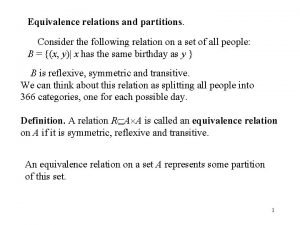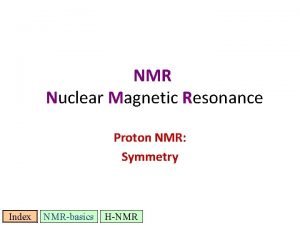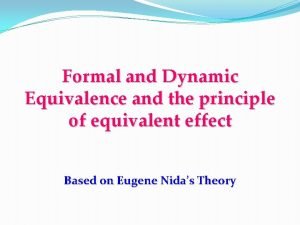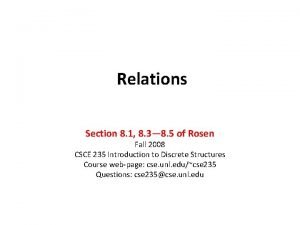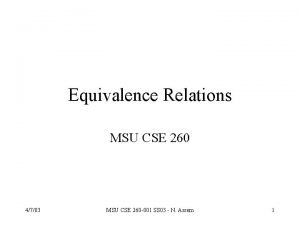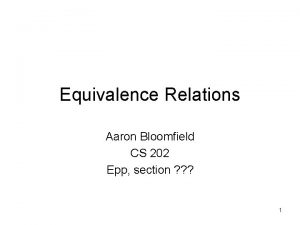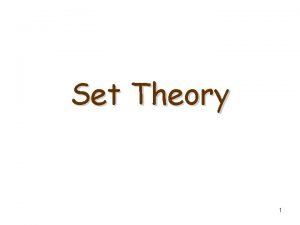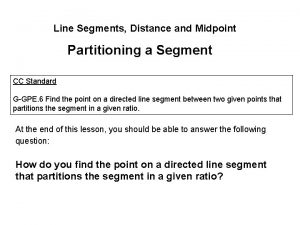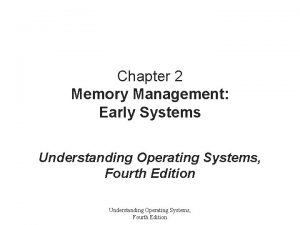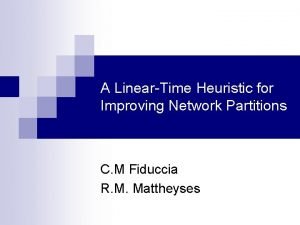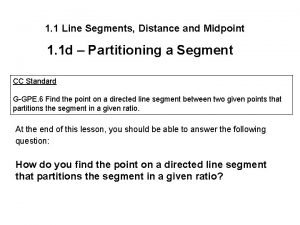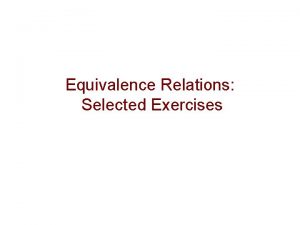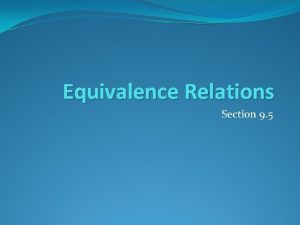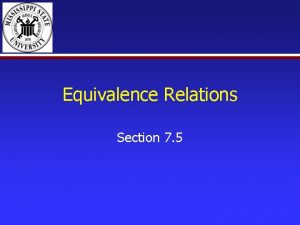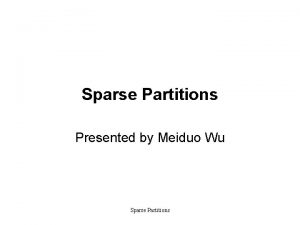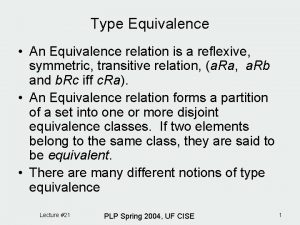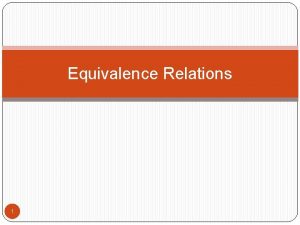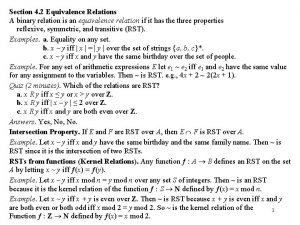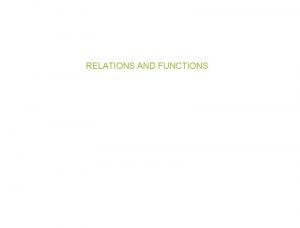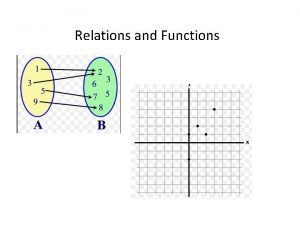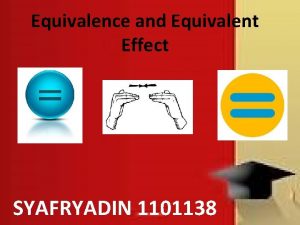Equivalence relations and partitions Consider the following relation




![x [x]R implies 2) To prove that A/R is pairwise disjoint we need to x [x]R implies 2) To prove that A/R is pairwise disjoint we need to](https://slidetodoc.com/presentation_image/716fe63a9025202ef53f590f83108c0e/image-5.jpg)















- Slides: 20

Equivalence relations and partitions. Consider the following relation on a set of all people: B = {(x, y)| x has the same birthday as y } B is reflexive, symmetric and transitive. We can think about this relation as splitting all people into 366 categories, one for each possible day. Definition. A relation R A A is called an equivalence relation on A if it is symmetric, reflexive and transitive. An equivalence relation on a set A represents some partition of this set. 1

Definition. For any set A subsets Ai A partition set A if • A = A 1 A 2 … An • Ai Aj= , for any i j. • Ai for any i A A 2 A 1 A 4 A 3 Example. A={1, 2, 3, 4}, ={{2}, {1, 3}, {4}} is a partition of A. 2

Definition. Suppose R is equivalence relation on a set A, and x A. Then the equivalence class of x with respect to R is the set [x]R={y A| y. Rx} In the case of the same birthday relation B, if p is any person, then the equivalence class of p [p]B={q P | p. Bq} ={q P | q has the same birthday as p} For example, if John was born on Aug. 10, [John]B= {q P | q was born on Aug. 10} The set of all equivalence classes of elements of A is called A modulo R and is denoted A/R: A/R={[x]R | x A} 3

We are going to prove that any equivalence relation R on A induces a partition of A and any partition of A gives rise to an equivalence relation. Theorem 1. Suppose R is an equivalence relation on a set A. Then A/R ={[x]R | x A} is a partition of A. Proof. To prove that A/R defines a partition, we must prove three properties of a partition. 1) The union of all equivalence classes [x]R equals A, i. e. Since any equivalence class is a subset of A, their union is also a subset of A. So, all we need to show is To prove this, suppose x A. Then x [x]R because [x]R ={y A | y. Rx }and x. Rx due to reflexive property of R. 4
![x xR implies 2 To prove that AR is pairwise disjoint we need to x [x]R implies 2) To prove that A/R is pairwise disjoint we need to](https://slidetodoc.com/presentation_image/716fe63a9025202ef53f590f83108c0e/image-5.jpg)
x [x]R implies 2) To prove that A/R is pairwise disjoint we need to show, that for any x, y A if [x] [y] then [x] [y]=. It is easier to prove the contrapositive: if [x] [y] , then [x]=[y]. So, assume [x] [y] , then we can find an element z [x] [y]. It implies that x. Rz and z. Ry by definition of equivalence classes. Then x. Rz and z. Ry implies x. Ry due to transitive property of R. We now claim that [x] [y]. Take any a [x], it implies a. Rx, which implies a. Ry because of x. Ry and transitive property of R. a. Ry implies a [y], i. e. [x] [y]. Similarly [y] [x], or [x]=[y]. 3) None of equivalence classes is empty, because for any x A, x [x]. 5

Theorem 2. Suppose A is a set and is a partition of A, i. e. is a set of disjoint nonempty subsets, such that any element of A belongs to exactly one subset. Then the relation R on A defined as R = {(x, y) | x, y A and x and y belong to the same subset in } is an equivalence relation on A. Proof. We need to prove that R is reflexive, symmetric and transitive. • R is reflexive because for any x A, x and itself belong to the same subset in . • R is obviously symmetric • Suppose x. Ry and y. Rz, that is x and y belong to the same subset and y and z belong to the same subset. This implies that x and z belong to the same subset in , thus x. Rz. 6

Definition. A partition P 2 is called a refinement of P 1 if every set in P 2 is a subset of one of sets in P 1. Example. Consider the partition P 1. ={{1, 3, 5, 7, 9}, {2, 4, 6, 8, 10}}, induced by the relation R 1 = {(x, y) | x = y mod(2)} on a set A = {1, 2, … 10}. Then the relation R 2 = {(x, y) | x = y mod(4)} induces a partition P 2. ={{1, 5, 9}, {3, 7}, {2, 6, 10}, {4, 8}}, which is a refinement of P 1. Theorem. Suppose R 1 and R 2 are equivalence relations on a set A. Let P 1 and P 2 are partitions that correspond to R 1 and R 2 respectively. Then R 1 R 2 iff P 1 is a refinement of P 2. 7

Partial Orders. A particular type of binary relation on a set. Definition. A binary relation R A A is a partial order, if it is reflexive, transitive and anti-symmetric. The set A together with the partial order relation is called a poset. Examples: ‘less or equal’ ‘greater or equal’ ‘subset’ relation ‘divides’ 8

Functions. Function is a special type of relation. Recall that in a relation R A B an element a A may be related to more then one element of B, or it may be not related to any. Definition. A function f : A B is a binary relation from A to B such that, for every a A there exists a unique (i. e. exactly one) element b B such that (a, b) f. If a A, write f(a) for corresponding element of B, b= f(a) A = domain a a is the pre-image of b f b= f(a) B = co-domain. b is the image of a; 9

f A B relation f is not a function f A B relation f is not a function 10

f A a 1 a 2 b 1 b 2 a 3 a 4 b 3 B f (A) = {b 1, b 3} The set of all images f (A) ={f (a)| a A} is the range of f. In general f (A) is a proper subset of B. 11

Assume |A|=n, |B|=m. How many different functions f : A B exist? Recall that there are 2 n m different relations R A B, but not all of them are functions. For relations we counted all subsets of A B. A function must include exactly n pairs, one for each element in A. Each of elements from the domain can be related to any element from co-domain. So, we have m choices for each pair, the total number of functions is mn. where 12

Properties of functions (surjective, injective, bijective ) Definition. Surjective (“onto”): range = co-domain. A function f : A B is called surjective, if for any b B there exists a A, such that f (a) = b. b B, a A (f (a)=b) f A a 1 a 2 a 3 a 4 b 1 b 2 B b 3 This function is not surjective because b 2 does not have any pre-image. 13

If we have two finite sets |A| < |B| f A a 1 a 2 b 1 b 2 B b 3 a surjective function f : A B is impossible. The necessary condition for a surjective function f : A B is |A| |B|. 14

Definition. Injective (“one-to-one”): a 1, a 2 A, a 1 a 2 f (a 1) f (a 2) A function f : A B is called injective, if for all a 1, a 2 A, a 1 a 2 f (a 1) f (a 2). Equivalently, it means f (a 1) = f (a 2) a 1 = a 2 f A a 1 a 2 a 3 b 1 B b 2 This function is not injective. 15

An injective function f : A B is possible if only |A| |B|. f A a 1 a 2 a 3 b 1 B b 2 f A a 1 a 2 a 3 b 1 b 3 B b 2 A function that is both injective and surjective is called bijective. For this we need |A| |B| and |A| |B|, i. e. |A| = |B|. 16

Pigeonhole Principle If n pigeons are put into m holes, n > m, then at least one hole contains two or more pigeons. Actually it is not about pigeons and holes. . . Restate in terms of functions: Theorem. Let A and B be finite sets, | A | > | B |. If f : A B then there exist distinct elements a 1 and a 2 in A such that f (a 1) = f (a 2) (that is f is not injective) A: pigeons B: holes f : says where each pigeon gets put Examples. Birthdays. 17

Examples: • f (x)=x 2 : R R is not injective, since both +x and -x have the same image. • f (x) = |x| : R R, is not surjective (but is surjective if regarded R R+) f A B f A Surjective, but not injective B Injective, but not surjective 18

Composition of functions B f A a f (a)=b C g g (b)=c g f (Note, that in the context of function composition, the order in which the functions appear is backward, i. e. the rightmost function is applied first) Theorem 4. Let f : A B and g: B C be two functions. The composition of f and g as relations defines a function g f : A C, such that g f (a)= g(f(a)). 19

Proof. We need to prove that composite relation g f is a function. For this we need to prove two things: 1) the composition g f relates each element a A to some c C. 2) an element c C assigned to a by g f is unique, so we can denote it c= g(f (a)). 1) existence: Let b=f (a) B. Let c=g(b) C. So, by the definition of composition of relations, (a, c) g f. Thus, c C [(a, c) g f ] 2) uniqueness: Suppose (a, c 1) g f and (a, c 2) g f. Then by the definition of composition, b 1 B, such that (a, b 1) f and (b 1, c 1) g, and b 2 B, such that (a, b 2) f and (b 2, c 2) g. Since f is a function, there may be only one b B, such that (a, b) f, so b 1= b 2. Since g is a function, (b, c 1) g and (b, c 2) g imply that c 1= c 2. Thus, (g f )(a)= c= g (b) = g (f (a)). 20
 Equivalence partitioning
Equivalence partitioning Consider the following relation
Consider the following relation Magnetically equivalent protons
Magnetically equivalent protons Example of formal equivalence
Example of formal equivalence Complete equivalence vs creativity
Complete equivalence vs creativity Crisp relation definition
Crisp relation definition Equivalence relation examples
Equivalence relation examples Equivalence relation
Equivalence relation Equivalence relation example
Equivalence relation example Equivalence relation
Equivalence relation Lab 5-2: create partitions and filesystems
Lab 5-2: create partitions and filesystems Lab 5-2: create partitions and filesystems
Lab 5-2: create partitions and filesystems Employee relations in public relations
Employee relations in public relations Bc scientific notation
Bc scientific notation Partitions of a set
Partitions of a set Partitioning a line segment
Partitioning a line segment Ratio midpoint formula
Ratio midpoint formula Relocatable dynamic partition
Relocatable dynamic partition A linear-time heuristic for improving network partitions
A linear-time heuristic for improving network partitions How to find a point that partitions a line segment
How to find a point that partitions a line segment Why are page sizes always powers of 2
Why are page sizes always powers of 2

